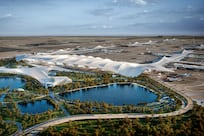The resource curse is an empirical term that applies to the failure of converting natural resource wealth into sustainable economic growth and equitable development. When the curse is in force, economic growth tends to be volatile with booms followed by busts.
And when some equitable distribution of income is achieved, it is more through government employment beyond the actual needs of the public sector and subsidies and handing out benefits largely irrespective of merit and need. In the worst cases, a large part of the population remains in poverty.
Even in countries where revenues are spent directly across the population under some paternalistic motives, education as well as productivity among citizens and more broadly labour market outcomes and human development lag behind, often significantly, compared to less fortunate countries with few natural endowments.
Examples abound, but take the case of Equatorial Guinea, one of sub-Sahara's largest oil producers and the richest country per capita in Africa. The World Bank estimates the country's annual per capita income to be more than US$30,000.
This puts it on par with the much-admired South Korea and ahead of Saudi Arabia, Oman and Bahrain. Equatorial Guinea is ranked 30th in the world in terms of income but only 136th on the Human Development Index. More than 70 per cent of people live in poverty. Many other African and also some Latin American oil-rich countries fare not better.
Although worlds apart from Equatorial Guinea, only two Arab countries (Jordan and Tunisia) score higher in the Human Development Index compared to their per capita incomes. Neither country is oil-rich. The resource curse can be traced in some of the oil-rich Arab countries. During the largely lost decades of the 1980s and most of the 1990s when oil prices tumbled, non-oil rich Arab economies managed to grow faster on average than the oil-rich ones. In fact, in some oil-rich countries there was a precipitous fall in per capita income.
Per capita incomes in Saudi fell from about $35,000 in 1980 to nearly $7,000 before the recent increase in oil prices and stands at about $25,000 today despite the threefold increase in the price of oil since the early 2000s.
Saudi Arabia can be compared to Norway. These two countries had practically the same GDP in both 1990 and 2005, up from $120 billion to $300bn. In both countries the share of industry GDP increased by 20 per cent between those dates.
In neither country is agriculture an important sector, while both are oil producers. The similarity between these two countries stops here. The big difference between them lies in the alignment of their economic model with the labour and more broadly social model.
Norway produces as much as Saudi Arabia with only one sixth of the latter's population. In other words, productivity of citizens in Norway is six times higher than that of Saudi residents. Norwegian citizens have minimal unemployment despite having long working lives and one of the highest employment rates of women in the world. The oil reserve fund is restricted from depleting its capital. It can nevertheless use its returns to amortise the effects of cyclical economic fluctuations and fuel growth.
Norway is one of the most admired welfare states, but social assistance is conditional on willingness but inability to find work, or poverty that arises from reasons beyond the control of individuals and families, such as disability. These characteristics are in contrast to those found in many other oil-producing economies.
What accounts for these differences between resource-rich countries? The oil curse is not just the revenue dependence and economic volatility it creates that make macroeconomic management difficult. It is the lack of congruence between the economic and social model. The economic model and social model of Norway come together through the principle of mutual responsibility of the government (to provide) and citizens to earn (not just be given).
Economic gains irrespective of their origins - be they from single resources or diversified activities - need to be converted into human capital and its efficient utilisation. Many blame education and the youth, but this is misplaced. The critical issue is good governance. Prudent management of current revenues is one thing. The other is sound investments for the future in both physical and human capital.
High oil prices encourage massive investment in the sector, but subsequent oversupply can create surprises. The current oil producers in the region can be eventually joined by new ones, such as Lebanon, Morocco and Mauritania, even Gaza. Shale oil may come into the markets from Jordan all the way to the United States. Of course, oil forecasts can turn out right or wrong. In the late 1990s the expectation was that oil prices might collapse to $5 a barrel. Instead they soared, peaking at $145 in 2008.
That is why the best way to predict the future is to create it. This can be done by governments hiring on the basis of public sector needs, and the private sector operating on the basis of competition (not privileges) and higher profits through productivity gains (not low wages of migrant workers). It would also require incentives for students to invest genuinely in education, not just for the sake of credentialism. Finally, it should reward workers on the basis of effort and performance, not simply nationality.
Zafiris Tzannatos is an economist living in the UAE and a former adviser to the managing director of the World Bank and professor and head of the economics department at the American University of Beirut
Myths and truths of the resource curse
The resource curse is an empirical term that applies to the failure of converting natural resource wealth into sustainable economic growth and equitable development.

Editor's picks
More from the national




